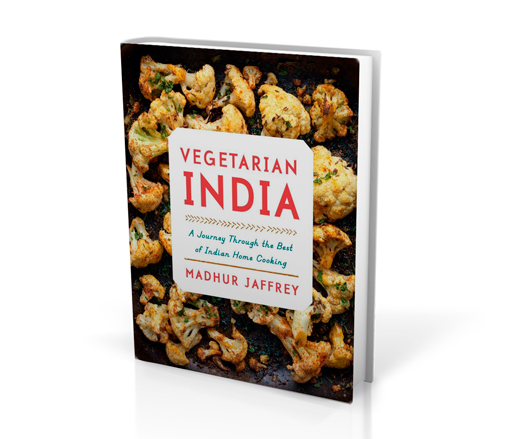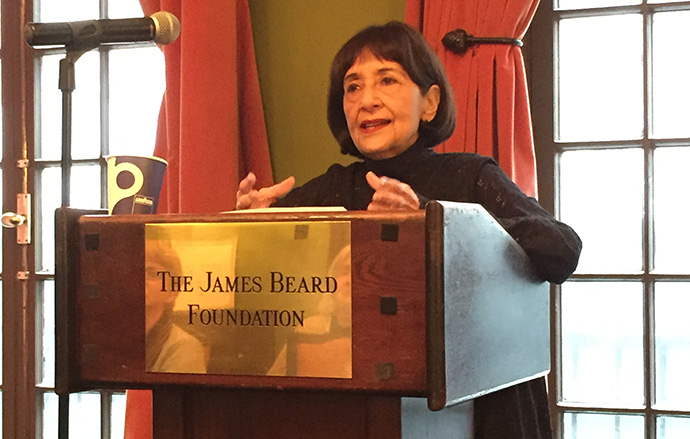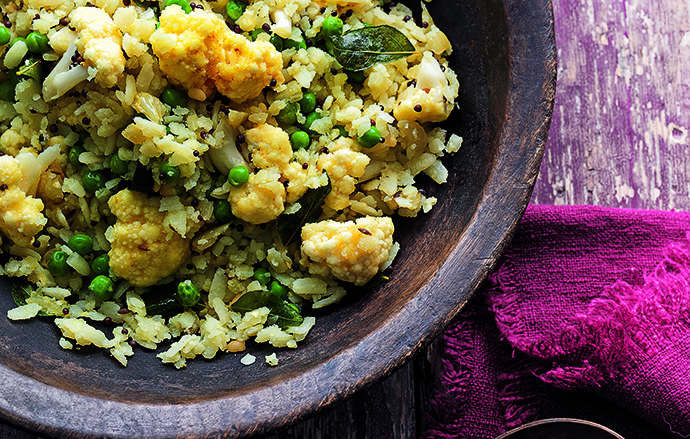The Bookshelf: Vegetarian India with JBF Award Winner Madhur Jaffrey
Maggie Borden
Maggie BordenFebruary 10, 2016

It’s no exaggeration to call Madhur Jaffrey the “Godmother of Indian Cooking.” The actress, chef, and multiple JBF Award–winning author has been guiding natives and Indophilic foreigners through the subtleties of the Subcontinent’s edible empire since her first cookbook was published in 1973. Last week, she visited the Beard House to share stories and insights from her latest work, Vegetarian India (Knopf), for our monthly Beard on Books series. During his introduction, JBF executive vice president Mitchell Davis explained that this was, in fact, a triumphant return—Jaffrey was the very first author to kick off our Beard on Books series, and even before that, was a friend “when there was no James Beard Foundation, only a James Beard.”
Read on for some of our favorite snippets from Jaffrey’s talk:
1) Nobody knows India. You simply can't go to all the parts of the country. India is as vast as the Europe we see today, and there are a number of states that are big as countries. Each state has its own culture and dress, and each state's food is as different from the others as Sweden and Italy.
2) In America, people are now trying to eat more vegetables and to change a diet based on meat. In India, from 4,000 BC to 500 BC, we were eating everything—horse, cow, peacock, wild boar, pigeons. Our diet was vast, it included lots of spices, seasonings, and a lot of meat and vegetables of every kind. So then what happened? Didn't vegetarianism begin in India? Well, Buddhism and Jainism started, and both are vegetarian, and all of a sudden these new religions had a lot of followers. The theory is that the Vedic priests got jealous of Buddhism and Jainism’s popularity, and decided create to their own vegetarian religion, and that’s how vegetarianism in Hinduism came to be, and the sacred cow with it.
3) One thing that has remained common in India food since the very beginning is that every food is analyzed for a variety of things. Is it healthy? Is it good for the body? What is the best spice to pair with what to help with digestion? What is the best to eat in which season to help with illnesses? All of this has been analyzed and written down in books, so when someone tells me they’ve decided to be vegetarian, I tell them to start with Indian food.
4) Turmeric is an antiseptic. People are saying all kinds of things now, advocating taking turmeric pills and all that, but we've known for centuries that it's an antiseptic. In fact, when I got my ears pierced as s girl and they got infected, my mother put turmeric on them, and I went to school with yellow ears! So when we're cooking fish in India, you always treat it first with salt and turmeric: the salt to make it firm, and the turmeric to ward off any infection.
5) Asafoetida—the name it self scares people, and I don't blame them! Asafoetida comes from the resin of a tree that grows in Iran, Afghanistan, and Pakistan. It's a digestif, and it's supposed to cure even horses of indigestion. What happens in the kitchen is that you put it in a little oil in a pan, and the smell dissipates (into your kitchen, unfortunately, but it doesn't go into the food). It gives the dish a truffly, garlicky taste. And it helps with digestion, so in India you never cook beans without asafoetida.
6) No Indian grandmother sits you down and teaches you the properties of spices. You learn by osmosis.
7) We treat spices like paint. You have a canvas, and using the spices you get different shades of color and flavor. We do that magically in India and it adds value to the food.

8) In this book I've tried to explore for you (and myself) all the things we have in India that haven't come to America yet.
9) The way you learn what people are actually eating in an area: just jump out of the car and see what people are eating on the street. What do they pair it with, do they eat it sitting down, standing up? What is the food of the humble chile picker? What is the food of a rich jeweler in the Taj Hotel?
10) I didn't want to go to big restaurants to get recipes, I wanted to get them from families cooking in their homes. I told them I didn't want a written recipe. I wanted to know how they cut the vegetables, when they turn down the heat—and then I jotted it down.
11) There is a technique to collecting recipes, and you can't always trust everyone to give you the right thing. You have to ask ten people for the recipe, and they each withhold a different thing, and you piece it together from there.
12) I wanted to go to parts of India that I had never been to before. There's a part of the Southwest of India called Coorg, where the mountains rise from the sea. In the rainy season, nothing grows and the people there eat only what they forage in the forest. They eat mushrooms, from tiny ones to ones as big as plates. For one dish, they make a fire and they roast the whole mushroom on a wood fire. They top it with a chutney—lime juice, cilantro, and salt, and they have it with a whiskey. It was called the Scotland of India. The food there is quite spectacular, and you will only find it in that area, because no other place in India has these foods.

13) Poha has existed in India since ancient times, and it was created to solve the problem of converting rice into traveling food. It is steamed in very little water in big vats, and then let dry, then roasted and pounded to get rid of the husk. All of the nutrients have gone into the grain at this point, so you end up with a dried, flattened rice that cooks in minutes.
14) Green chiles give a very special flavor to Indian dishes that you can't get from just using chile powder. Use Thai chiles, cayenne-type chiles. The best way to test their heat is to break the chile in the middle and taste a little bit.
15. I love every food, so we cook Italian, we cook Thai, we cook Chinese, Japanese, French. My husband makes a wonderful apple pie.
--
Learn more about the James Beard Foundation’s Beard on Books program.



-57 web.jpg)


